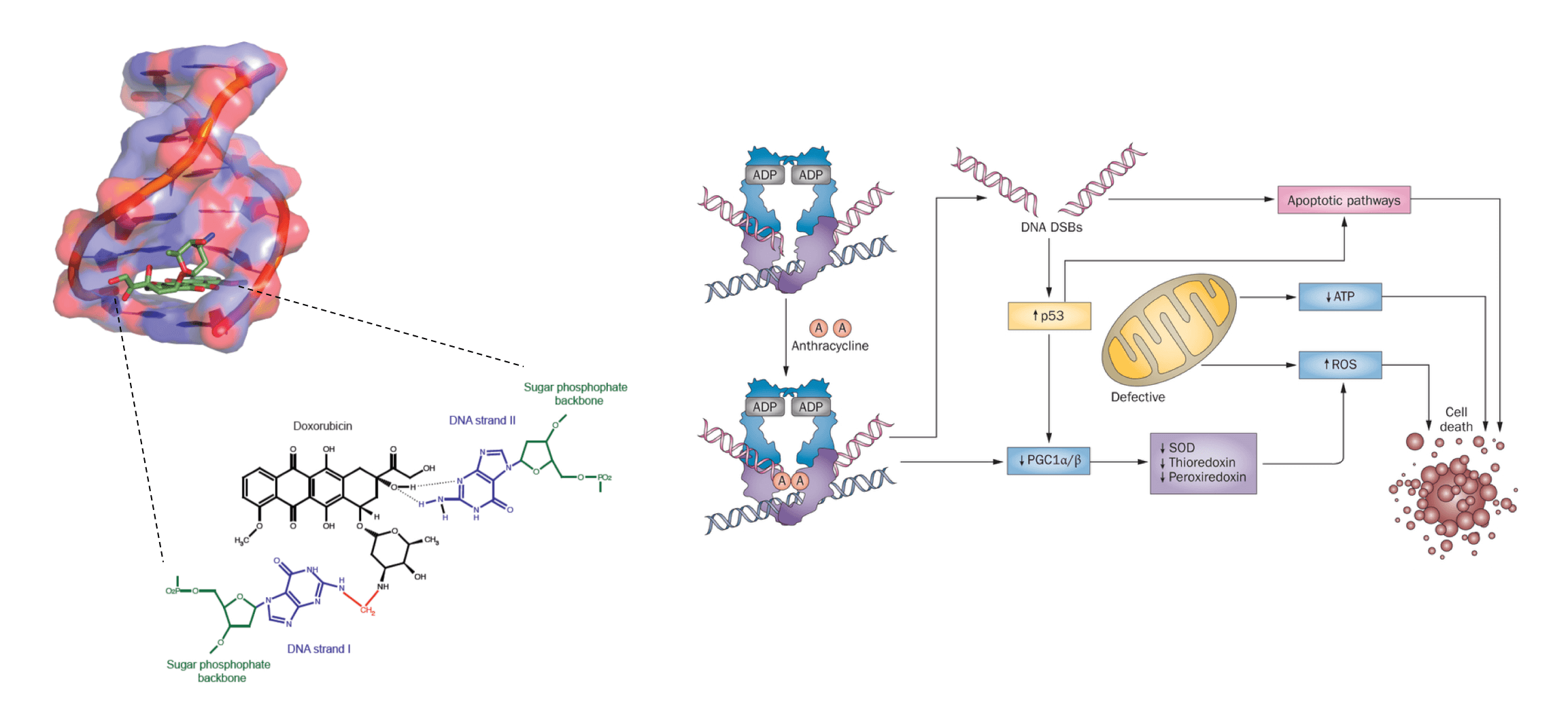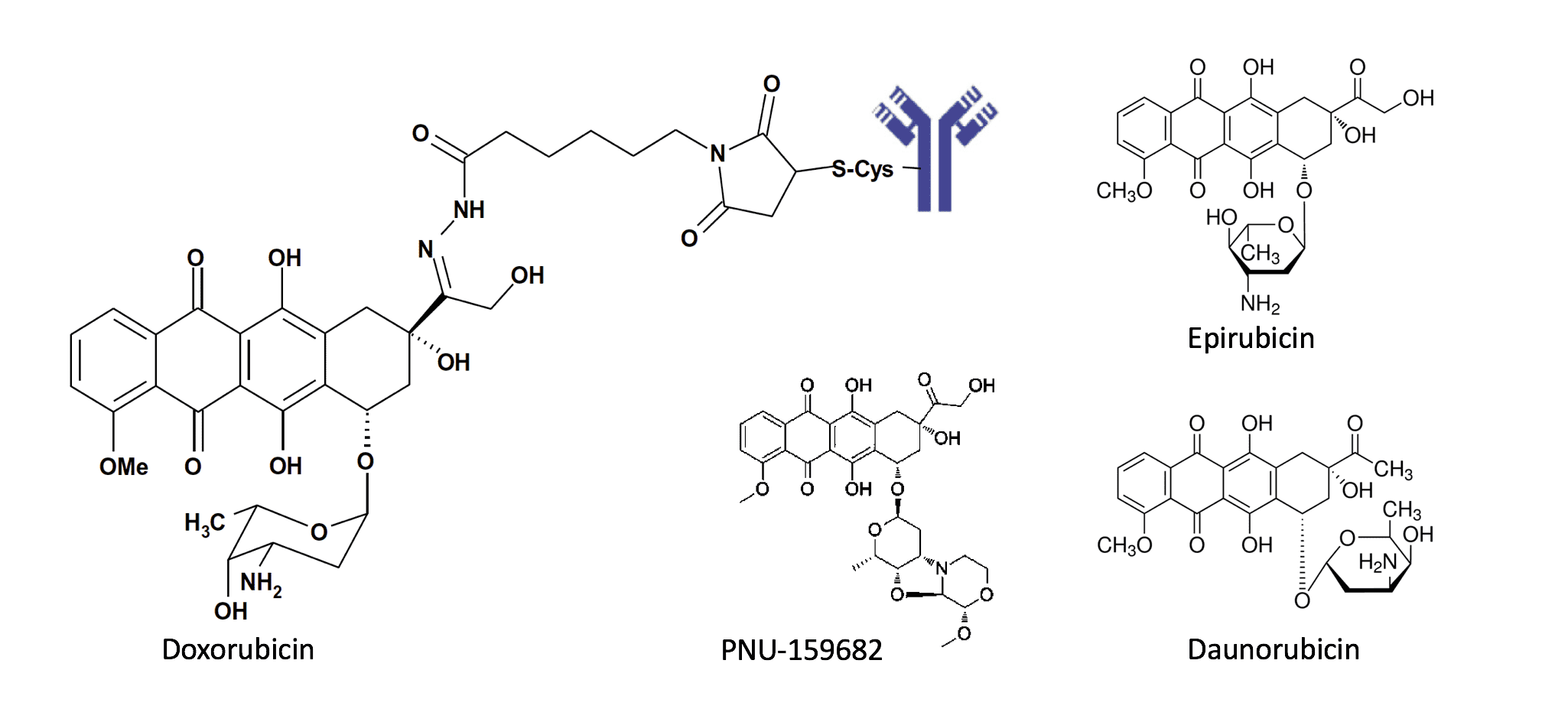Doxorubicins
With our advanced “DrugLnk” platform and extensive experience in synthetic chemistry and bio-conjugation, Creative Biolabs offers highly customized strategies for antibody-drug conjugates (ADCs) production and targeted antibody therapy development using doxorubicin or doxorubicin derivatives as payloads.
Doxorubicin, often regarded by the trade name “adriamycin”, is a member of the anthracycline compounds derived from Streptomyces peucetius var. caesius in the 1960s. These compounds were given the name doxorubicin or daunorubicin. Doxorubicin and its derivatives, function by DNA helix intercalation, topoisomerase poisoning, free radical generation…, are still regarded as some of the most impactful chemotherapeutic antitumor agents. Doxorubicin is a 14-hydroxylated version of daunorubicin and is has been applied to the treatment of a broad range of both solid and liquid tumors. However, the appearance of drug resistance and possible side effects, for example, heart muscle injure after doxorubicin treatment, result in a narrow therapeutic window for doxorubicin-based cancer treatments. For this regard, ADCs are becoming an appearing alternative for targeted doxorubicin delivery to expand its therapeutic window.
Doxorubicin mode of action (MOA)
Doxorubicin and its derivatives function by inducing DNA damage at a structural level, at various stages during DNA replication and transcription, and by increasing cellular oxidative stress. As a DNA intercalator, doxorubicin forms hydrogen-bonds with guanine and intercalate into the DNA strand at sites with adjacent GC base pairs. This process has been shown to trigger DNA damage responses and induce cell death. A second, probably the most well-known, MOA of doxorubicin is through topoisomerase II poisoning, where it traps the topoisomerase II at the DNA breakage sites by stabilizing the cleavage complexes and thus prevent DNA resealing. Topoisomerase II poisoning by doxorubicin disrupts DNA replication and transcription, resulting in apoptosis mediated cell death. What’s more, the oxidation of doxorubicin quinone structure results in semi-quinone radical formation and subsequently, superoxide and H2O2 generation that leads to elevated oxidative stress, which eventually leads to DNA damage. Accompanied by the increase of cellular oxidative stress, doxorubicin treatment also results in an increased cellular ceramide level, triggering processes such as growth arrest, apoptosis, and senescence.
 A figure illustration of doxorubicin DNA intercalation (left, Biochim. Biophys. Acta., 2014) and doxorubicin induced topoisomerase II poisoning (right, Nat Rev Clin Oncol., 2015), major doxorubicin mode of actions that leads to DNA damage and cell death.
A figure illustration of doxorubicin DNA intercalation (left, Biochim. Biophys. Acta., 2014) and doxorubicin induced topoisomerase II poisoning (right, Nat Rev Clin Oncol., 2015), major doxorubicin mode of actions that leads to DNA damage and cell death.
Doxorubicin-based ADCs
ADCs provide preferential delivery of cytotoxic agents into targeted cancer cells, thereby decreasing cellular cytotoxicity of the payload drugs to healthy tissues. Doxorubicin-based ADCs has been designed. One example is an ADC produced by the conjugation of doxorubicin to anti-CD74 monoclonal antibody (mAb). The resulted ADC showed improved clinical efficacy in both total response and survival rates comparing to either the mAb or doxorubicin alone. Recently, another new ADC, trastuzumab-doxorubicin conjugate (T-Dox), was successfully developed by conjugating doxorubicin to trastuzumab via a thioether linkage. T-Dox showed good biophysical stability and an enhanced anti-cancer efficacy comparing to trastuzumab and a wider therapeutic window relative to doxorubicin. Several highly potent doxorubicin derivatives, including daunorubicin, epirubicin, and a nemorubicin metabolite—PNU-159682, are also being actively developed as ADC payloads.
 Structures of a doxorubicin ADC and other doxorubicin derivatives that are potential candidates as ADC payloads. The ADC is comprised of a chimeric anti-LewisY cBR96 mAb conjugated with doxorubicin via an acid-labile hydrazone linker to release the payload inside the cytosome of targeted cancer cells, thereby increase the total efficacy of doxorubicin (Bioorg. Med. Chem. Lett., 2014).
Structures of a doxorubicin ADC and other doxorubicin derivatives that are potential candidates as ADC payloads. The ADC is comprised of a chimeric anti-LewisY cBR96 mAb conjugated with doxorubicin via an acid-labile hydrazone linker to release the payload inside the cytosome of targeted cancer cells, thereby increase the total efficacy of doxorubicin (Bioorg. Med. Chem. Lett., 2014).
With our well-established “DrugLnk” organic synthesis platform, the experienced scientists here at Creative Biolabs is dedicated to help our clients develop doxorubicin-linker complexes using readily available or customized linkers for antibody conjugation in a timely and cost-effective manner. Our customarily tailored services and high quality products will contribute greatly to the success of your projects. Creative Biolabs also provides other various services regarding ADC development. Please feel free to contact us for more information and a detailed quote.
References:
- Yang, F.; et al. Doxorubicin, DNA torsion, and chromatin dynamics. Biochim Biophys Acta. 2014, 1845(1): 84–89.
- Brown, S.; et al. Systems biology approaches to adverse drug effects: the example of cardio-oncology. Na. Rev. Clin. Oncol. 2015, 12: 718–731.
- Bouchard, H.; et al. Antibody–drug conjugates—a new wave of cancer drugs. Bioorg. Med. Chem. Lett. 2014, 24: 5357–5363.
For Research Use Only. NOT FOR CLINICAL USE.
Related Sections
Drug Module:
Welcome! For price inquiries, please feel free to contact us through the form on the left side. We will get back to you as soon as possible.
Contact usUSA
Tel:
Fax:
Email:
Europe
Tel:
Email:
Germany
Tel:
Email:

